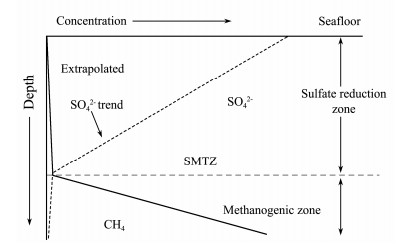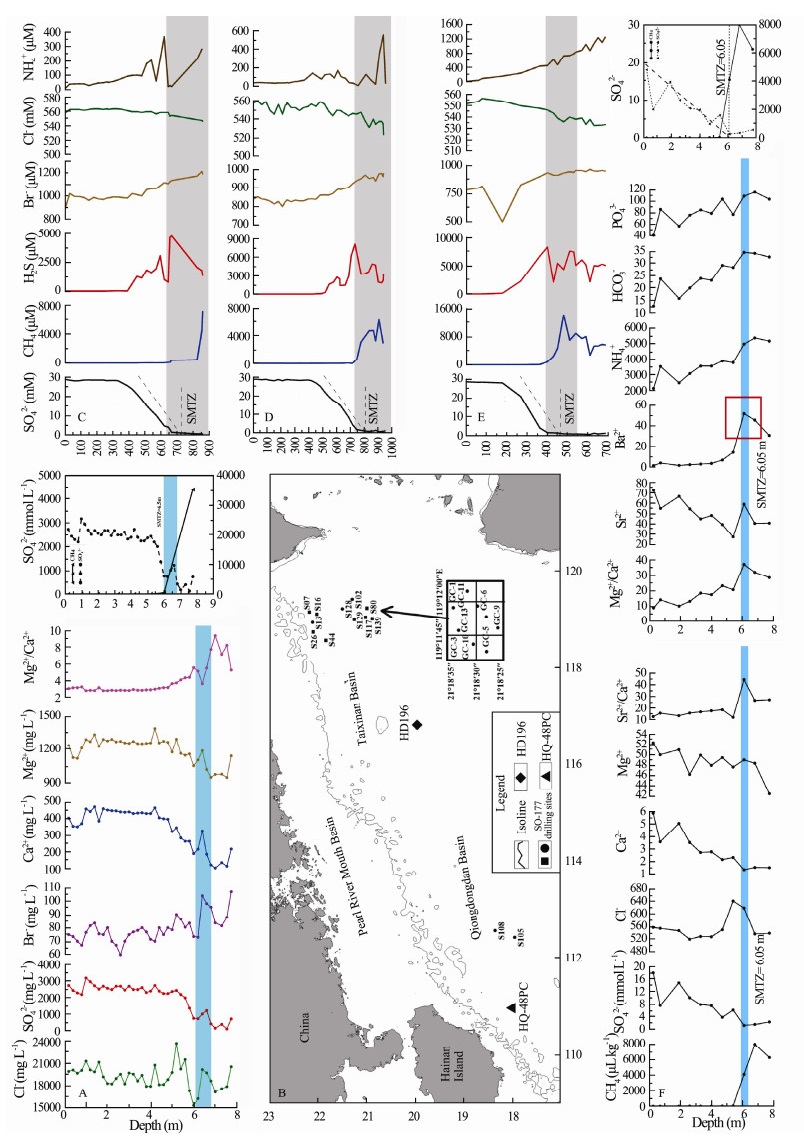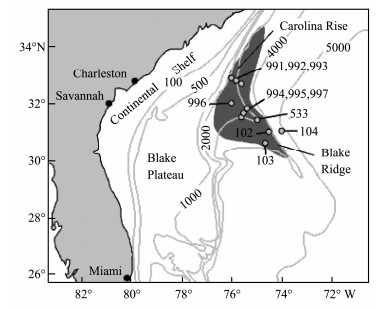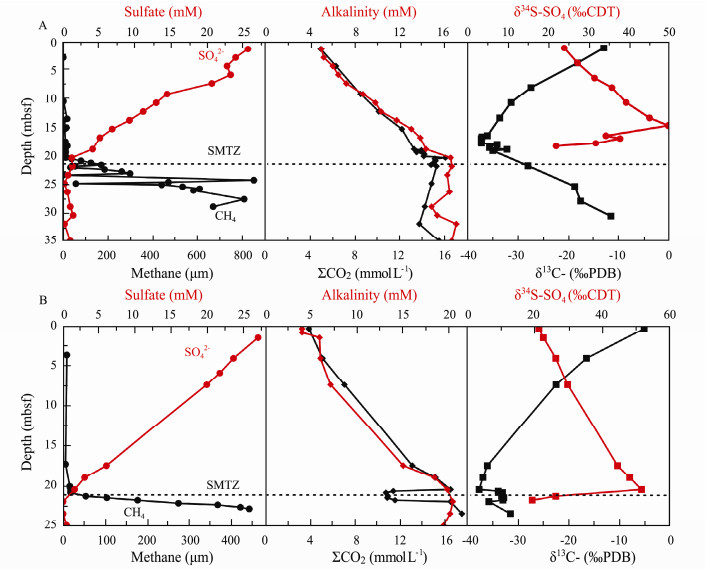Gas hydrate, also known as methane clathrates or clathrate hydrates, are ice-like solid substances formed by water and gas under conditions of low temperature and high pressure (Kvenvolden, 1993; Yu et al., 2014). Globally, gas hydrates have been identified from geophysical, geochemical and geological surveys, and by drilling and coring (Boswell and Saeki, 2010), the detection of gas hydrate is based on the occurrence of bottom simulating reflectors (BSRs) on seismic sections (Borowski et al., 1996). Evidence suggests that BSRs correspond to the base of gas hydrate stability below which gaseous methane may occur. It is generated by the large impedance contrast between high-velocity gas hydrate-cemented sediments and low-velocity free gas beneath (Ludmann and Wong, 2003). However, results from ODP Leg 164 indicate that gas hydrates are present in the hydrate stability zone (HSZ) even where a BSR is absent and that the impedance contrast generating the BSR is principally caused by gas, not hydrate (Holbrook et al., 1996). A number of studies suggested that the Sulfate-Methane Transition Zone (SMTZ) is an important biogeochemical indication for the area with high methane flux and gas hydrate occurrence (Wu et al., 2013). For organic-rich marine sediments, methanogenesis process may be going on relatively shallow depth under sediment water transition and form a relatively high concentration of methane, there final destinations are: 1) spreading upward migration to the overlying sediments; 2) saving as the dissolved gas phase in the sediments or forming methane hydrate under suitable conditions; 3) directly into the overlying water body in the form of bubbles (Martens et al., 1980; Wu et al., 2009). Sulfate reduction refers to microbially mediated diagenetic processes that deplete sulfate within interstitial pore waters. In anoxic marine sediments, sulfate reduction is generally the most important remineralization process (Reeburgh, 1983, Borowski et al., 2000). In the chemical reaction, sulfate is used as an oxidant by a consortium of microbes to decompose sedimentary organic matter (SOM) represented by the reaction 2(CH2O)+SO42−→2HCO3− + H2S. The second chemical reaction involving sulfate occurs within a localized horizon at SMTZ, sulfate and methane are consumed at the base of the sulfate reduction zone shown by the reaction: CH4 + SO42−→HCO3− + HS− + H2O, the so called anaerobic methane oxidation (AMO). AMO always dominates whenever the gas hydrate occurs, as the second reaction consumes less energy than the first one (Wu et al., 2013). Immediately below the sulfate reduction zone and SMTZ is the methanogenic zone. Here, methane is produced by interstitial microbes, and methane concentrations at least initially are increasing with depth (Fig. 1). Within marine sediments, microbially mediated methane production generally occurs through two distinct pathways: CO2 reduction (CO2 + 4H2 = CH4 + 2H2O) and acetate fermentation (CH3COOH = CH4 + CO2). Most occurrences of the world's marine gas hydrates coincide with surface sediments rich in total organic carbon (TOC ≥ 1%). However, therefore there is no straightforward relationship between sedimentary organic matter, methane production and the occurrence of gas hydrates (Borowski et al., 1999). Here, we propose that large methane concentrations associated with sulfate consumption and the importance of AMO reaction in sulfate depletion. In order to determine these relationships, we select some typical sites in South China Sea and Carolina Rise Blake Rise (CR-BR) area to analysis the relationships between SMTZ and methane flux.

|
Fig. 1 Schematic diagram showing the relationship between biogeochemical zonation within anoxic marine sediments (Modified by Borowski et al. (1999)). |
The data are from cruise SO-177 (Sites GC-9, GC-10, GC-11), cruise HY4-2005-4 (Site HQ-48PC) and Ocean Drilling Program (ODP) 164 (Sites 994, 995) cruise. In addition, site HD196 was located in the cold seep area of Jiulong Methane Reef in South China Sea. All the pore water samples were collected on the ship, sealed and stored in a 4℃ cold storage. Samples from the South China Sea are mainly made of clay and silty. The pore water is extracted by vacuum filtration. Sites GC-9, GC-10 and GC-11 pore water ion concentration were determined by High Performance Liquid Chromatography (HPLC) and methane concentration was measurement by gas chromatography. For sites HD196 and HQ-48PC the pore water ion concentration were determined by gas chromatography. Procedures for collecting sediments of ODP sites 994 and 995 were described in Borowski (1999). Sulfate concentration was determined by ion chromatography, and alkalinity was measured by titration (Gieskes et al., 1991). Total carbon dioxide (ΣCO2) was measured onshore using cryogenic and manometric techniques. Sulfate within pore waters was precipitated as barium sulfate and then reduced to SO2 for isotopic measurement. Ion concentration in pore water were determined by ion chromatography.
3 SMTZ Depth in Northern South China SeaThe South China Sea is a marginal basin in the Western Pacific Ocean, which located in the intersection of Eurasia-Australia plate and the Pacific plate (Deng et al., 2006; Lu et al., 2013). There are thick Mesozoic and Neogene sediments with high organic matters, which shows a good prospect for gas hydrate exploration in the northern continental slope. The results of present study showed that several BSR zones were found in this area. Meanwhile, a series of special structures which may be related to gas hydrate have developed in the South China Sea, such as: sliding body, mud diapir, accretionary wedge. After the seafloor expansion and strong compression in early Cenozoic, there formed numerous sedimentary oil and gas basin. At present, Taixinan Basin, northeast of Dongsha Basin, Baiyun Sag and Qiongdongnan Basin are the four active development areas of leakage type natural gas hydrate (Wu et al., 2009). Through the analysis of typical stations in the northern South China Sea, it is obvious that the SMTZ is shallow in all these sites (less than 7 m) (Fig. 2). The methane content in the underlying sediments determines the upward methane flux, and indirectly controls the AMO rate, SMTZ depth and the sulfate flux. If the methane flux is high, the SMTZ will be shallow and thereafter to infer the possible occurrence of gas hydrate.

|
Fig. 2 Station distribution and pore water ion concentration variations of northern South China Sea. (A), site HD196; (B), Station location distribution in northern South China Sea; (C), site GC-9; (D), site GC-10; (E), site GC-11; (F), site HQ-48PC. The red square in F represents the 'barium front'. |
For example, site HQ-48PC, with the increase of depth, PO43− and NH4+ show an obvious upward trend, the variation is roughly mirror-image with the decline trend of SO42−. It indicates that the organic matter in the sediment is relatively enriched and the biological activity is relatively strong. The depth of SMTZ is about 6.05 m, and a strong methane anaerobic oxidation reaction occurred at SMTZ. Since SO42− is almost consumed by AMO, it is difficult to react with Ba2+ to form barite, thereby increasing the Ba2+ concentration and forming a 'barium front' (Fig. 2).
At site HD196, the methane content in the sediment increases significantly with depth, from 1.21 mL kg−1 to 35208.8 mL kg−1, which indicating that there is a rich supply of hydrocarbon gases in the deeper part of the station. At 500 cm, the concentration of SO42− decreased sharply in the deep part, from 2439 mg L−1 to 126 mg L−1 within a range of 200 cm. The marcoelement at 520 cm coincides with changes in SO42− concentration and CH4 content may also indicate the existence of natural gas hydrate (Fig. 2).
Sites GC9, GC10, GC11 are located in the Dongsha area on the northern slope of the South China Sea. As shown in Fig. 2, all these three sites have shallow SMTZ (less than 10 m). Above the SMTZ, because the organic matter content in the surface sediments is basically the same, however the CH4 flux did not affect SO42−, SO42− maintained in a stable state above the SMTZ; with a steep linear decrease trend with increasing depth, which indicating that the sulfate content in the pore water is mainly affected by the methane anaerobic oxidation of the underlying methane fluid (Wu et al., 2013).
4 SMTZ depth in Carolina Rise and Blake RidgeThe Carolina Rise (CR), particularly along the Blake Ridge (BR), was one of the first areas where marine gas hydrate was first identified on the basis of a BSR. It is also an area where gas hydrate appears to be especially extensive (Fig. 3) and might be considered the 'type section' for marine gas hydrate. Many Deep Sea Drilling Project (DSDP) and Ocean Drilling Program (ODP) drilling sites also occur in the CR-BR region (Fig. 3). DSDP Leg 11 (Sites 102, 103, 104) and Leg 76 (Site 533) sites were drilled over strong BSRs. More recently, ODP 164 (Sites 991-997) conducted coring operations with the purpose of investigating marine gas hydrates. These sites show that the Blake Ridge is a major Neogene and Quaternary sediment drift that consists of hemipelagic silt and clay rich contourite deposits. One significant aspect of the seafloor morphology of the southern Carolina Rise is that it lacks submarine canyons. Apparently, little sediment makes it across the continental shelf, under the Gulf Stream, across the Blake Plateau, and out to the Carolina Rise (Dillon et al., 1982; Paull et al., 1989). In this paper, we only selected Sites 994 and 995 in order to determine the relationship between SMTZ depth and methane flux.used. ΣCO2 concentration increase monotonically as sulfate concentration decrease and show little variation immediately below the transition (Fig. 4). The data from these two sites are stratigraphically sparse near the sulfate-methane transition, so we have also included alkalinity values. Because of the concentration of alkalinity are control by ΣCO2 in this system. As we can see in the figure, the structure of alkalinity is similar with ΣCO2 profiles. The values are almost linear in the upper sulfate reduction zone. The carbon isotopic values are near 0 at the surface and decreased rapidly with depth at both sites. Each site shows that heavy sulfur (34S) becomes enriched with increasing depth into SMTZ.

|
Fig. 3 Map of DSDP and ODP piston cores location off the southern coast of the United States. Gray region in offshore is the distribution of gas-hydrate inferred from seismic and other data (Modified by Borowski et al., 1999). |

|
Fig. 4 Pore-water concentration profiles for sulfate and methane; total dissolved carbon dioxide (black line); alkalinity (red line) and isotopic composition profiles of δ13C ΣCO2 (black line) and δ34S (red line) for (A) Site 994 and (B) Site 995. The sulfate-methane transition zone is shown by the horizontal dashed lines. Sediment depths are expressed in meters below sea floor (mbsf) (Borowski et al., 1999). |
The necessary conditions for the formation of marine gas hydrate are: 1) sufficient CH4 source, the sediment should be rich in organic matter and be buried quickly. This is because the main component of hydrate is methane, which is mainly formed by the action of organic matter; 2) the porosity of the sediment is relatively high and contains sufficient interstitial water to provide cementation space for the formation of natural gas hydrates; 3) low temperature (< 10℃), high pressure (> 10 MPa), 0-1500 m below the sea floor. Kvenvolden et al. (1985) believes that as long as the deposition rate is greater than 30 m/Ma and the organic carbon content reaches 0.5%, the biogenic methane required for hydrate formation can be met. If the organic carbon is less than 0.5%, it is difficult to form natural gas hydrates (Paull et al., 1995, Deng et al., 2006). As the sites we mentioned above, the Blake Ridge has a deposition rate of 160-190 m Ma−1 during the Late Oligocene to Holocene. The Dongsha Islands, especially its southeast part has the highest sedimentation rate in the southern China Sea. In addition to the temperature, pressure and gas source condition, the neotectonics and magmatic diapir structure in this area are very mature developed, and there are huge late Cenozoic sediments and high heat flux value, which created conditions for the formation of natural gas hydrates (Shipboard Scientific Party, 1999). Obviously, in the Dongsha Islands the deposition rate is higher than 30 m Ma−1. From the perspective of the organic content of these sites, its content is more than 0.7%, it can meet the gas source conditions for natural gas hydrate formation. In addition, the Dongsha Islands area began to submerge after the Miocene in the basal highlands. This is similar to the Blake Ridge in the passive continental margin hydrate development area in the eastern United States. The Blake ridge and Carolina Rise area is a passive continental margin comprised of thinned continental, transitional rift and oceanic crust mantled by sediments of Late Mesozoic and Cenozoic age (Borowski, 2004). According to the pore water ion concentration from Southern China Sea we can found that the concentration changes of ion in pore water is consistent with methane. In addition, the SMTZ depths are shallow in these two areas (less than 20 m). All the characteristics indicate that southern China Sea, Blake ridge and Carolina Rise are both suitable for the development of natural gas hydrate.
The sedimentation rate determines directly the burial of organic matter and its variance. The ideal ratio of CH4 and SO42− in AMO reaction is 1, when the ratio > 1 implies that the supply of CH4 through upward diffusion from deeper sediments is not sufficient to explain all of SO42− consumption at the SMTZ (Flury et al., 2016). Matthias et al. (2018) provide a global methane and sulfate flux ratio in marine sediments, 72% of the sediments, the SO42− flux exceeds the CH4 flux, with a global mean flux ratio between 1.4:1. It suggested that only 70% of the methane has been consumed in the sulfate-methane transition zone on average, the supply of CH4 through upward diffusion from deeper sediments is not sufficient to explain all of the SO42− consumption at the SMTZ. Their results suggest that a small shoaling of the SMTZ depth can cause a strong enhancement of methanogenesis at the expense of SO42− reduction (Egger et al., 2018). Based on Fick's First Law, the sulfate flux from seafloor to SMI may be calculated by the following equation:
| $ J = {D_0}{\varphi ^3}{\delta _c}/{\delta _x}. $ |
In this equation, J expresses flux, D0 the diffuse coefficient of the sulfate, φ the sedimentary porosity. δc/δx the variation gradient of the sulfate concentration with the depth. The sulfate concentration of the pore water of sites 994 and 995 shows the linearity relationship, but the relationship is not obvious in the shallow part ODP 204 site 1244, which suggests that sulfate concentration is not completely controlled by AMO. In northern continental slope of South China Sea, high methane flux (3.8 × 10−3- 5.9 × 10−3) in Sites GC-9, GC-10 and GC-11 indicate that the possibility of hydrate occurrence in this region is great.
6 ConclusionsThe pore water data taken from these potential gas hydrate areas show that the depth of SMTZ is shallow which suggest the methane flux is high. Upward methane flux from buried methane reservoirs links methane concentration gradients to sulfate depletion through the diagenetic process of anaerobic methane oxidation. The wide occurrence of a linear sulfate gradients in South China Sea, Blake Ridge and Carolina Rise also suggests that AMO is an important additional process in these gas hydrate sediments. Especially for coastal systems where the SMT is shallow the high CH4 production may lead to an abrupt displacement of the CH4 oxidation barrier. How does the AMO balance the additional CH4 production from the seabed in continental shelf still controversial issue.
AcknowledgementsThis study was jointly funded by the Key Geological Issues in China Sea, the China Geological Survey (Nos. DD20160147 and GZH201100202), and the Taishan Scholar Project Grant to Guangxue Li.
Borowski, W.S., Paull, C.K. and Ussler, Ⅲ W., 1996. Marine pore-water sulfate profiles indicate in situ methane flux from underlying gas hydrate. Geology, 24: 655-658. DOI:10.1130/0091-7613(1996)024<0655:MPWSPI>2.3.CO;2 (  0) 0) |
Borowski, W.S., Paull, C.K. and Ussler, Ⅲ W., 1999. Global and local variations of interstitial sulfate gradients in deep-water, continental margin sediments:Sensitivity to underlying methane and gas hydrates. Marine Geology, 159: 131-154. DOI:10.1016/S0025-3227(99)00004-3 (  0) 0) |
Borowski, W.S., 2004. A review of methane and gas hydrates in the dynamic, stratified system of the Blake Ridge region, offshore southeastern North America. Chemical Geology, 205: 311-346. DOI:10.1016/j.chemgeo.2003.12.022 (  0) 0) |
Borowski, W.S., Hoehler, T.M., Alperin, M.J., Rodriguez, N.M. and Paull, C.K., 2000. Significance of anaerobic methane oxidation in methane-rich sediments overlying the Blake Ridge gas hydrates. Proceeding of the Ocean Drilling Program, Scientific Results, 164: 87-99. (  0) 0) |
Boswell, R. and Saeki, T., 2010. Motivation for the geophysical investigation of gas hydrates. In:Geophysical Characterization of Gas Hydrates, Society of Exploration Geophysicists Geophysical Developments Series.Riedel M., et al.eds., 14: 23-32. (  0) 0) |
Deng, X.G., Fu, S.Y., Huang, Y.X., Zhang, G.X., Wu, N.Y. and Wu, L.S., 2006. Geochemical characteristics of sediments at site HD196 in Dongsha Islands the north of the South China Sea and their implication for gas hydrates. Geoscience, 20(1): 92-102. (  0) 0) |
Dillon, W.P., Popenoe, P., Grow, J.A., Klitgord, K.D., Swift, B.A., Paull, C.K. and Cashman, K.V., 1982. Growth faulting and salt diapirrism:Their relationship and control in the Carolina Trough, Eastern North America. In:Studies of Continental Margin Geology, AAPG Mem.Riedel M., et al.eds., 34: 21-46. (  0) 0) |
Egger, M., Riedinger, N., Mogollon, M.O. and Jorgensen, B.B., 2018. Global diffusive fluxes of methane in marine sediments. Nature Geoscience, 11: 421-425. DOI:10.1038/s41561-018-0122-8 (  0) 0) |
Fulry, S., Roy, H., Dale, W., A, ., Fossing, H., Toth, Z., Spiess, V., Jensen, B.J. and Jorgensen, B.B., 2016. Controls on subsurface methane fluxes and shallow gas formation in Baltic Sea sediment (Aarhus Bay, Denmark). Geochimica et Cosmochimica Acta, 188(1): 297-309. (  0) 0) |
Gieskes, J.M., Gamo, T., and Brumsack, H., 1991.Chemical methods for interstitial water analysis aboard JOIDES Resolution.ODP Tech.Note, 15.
(  0) 0) |
Holbrook, W.S., Hoskins, H., Wood, W.T., Stephen, R.A. and Lizarralde, D., 1996. Methane hydrate and free gas on the blake ridge from vertical seismic profiling. Science, 273: 1840-1842. DOI:10.1126/science.273.5283.1840 (  0) 0) |
Kvenvolden, K.A., 1985. Comparison of marine gas hydrate in sediments of an active and passive margin. Marine and Petroleum Geology, 2: 65-71. DOI:10.1016/0264-8172(85)90049-2 (  0) 0) |
Kvenvolden, K.A., 1993. Gas hydrates-geological perspective and global change. Reviews of Geophysics, 31: 173-187. DOI:10.1029/93RG00268 (  0) 0) |
Lu, Z.Q., He, J.X., Jin, C.S., Liu, H., Zhu, Y.H., Yang, S.X., Zhang, G.X., Huang, X. and Wang, P.K., 2013. A study of modeling the effects of gas sources on gas hydrate formation in the northern slope of South China Sea. Chinese Journal of Geophysics, 56(1): 188-194. (  0) 0) |
Ludmann, T. and Wong, H.K., 2003. Characteristics of gas hydrate occurrences associated with mud diapirism and gas escape structures in the northwestern Sea of Okhotsk. Marine Geology, 201: 269-286. DOI:10.1016/S0025-3227(03)00224-X (  0) 0) |
Martens, C.S. and Klump, J.V., 1980. Biogeochemical cycling in an organic rich coastal marine basin, I. Methane sediment water exchange process. Geochimica et Cosmochimica Acta, 44: 471-490. (  0) 0) |
Paull, C.K., Schmuck, E.A., Chanton, J., Manheim, F.T., and Bralower, T.J., 1989.Carolina Trough diapirs: Salt or shale?EOS, 70: 370.
(  0) 0) |
Paull, C.K., Spiess, F.N., Ussler, Ⅲ.W and Borowski, W.S., 1995. Methane-rich plumes on the Carolina continental rise:Associations with gas hydrates. Geology, 23: 89-92. DOI:10.1130/0091-7613(1995)023<0089:MRPOTC>2.3.CO;2 (  0) 0) |
Reeburgh, W.S., 1983. Rates of biogeochemical processes in anoxic sediments. Annual Review of Earth and Planetary Sci-ences, 11: 269-298. DOI:10.1146/annurev.ea.11.050183.001413 (  0) 0) |
Shipboard Scientific Party, 1999.Leg 184 summary: Exploring the Asian monsoon through drilling in South China Sea. Proceedings of the Ocean Drilling Program, Initial Report.College Station, Texas, Texas A & M University (Ocean Drilling Program), 1-77.
(  0) 0) |
Wu, D.D., Wu, N.Y., Ye, Y., Han, X.Q., Huang, Y.Y. and Suess, E., 2009a. Petrographic characteristics of authigenic carbonates from Jiulong methane reef of northern South China Sea. Journal of Tropical Oceanography, 28(3): 74-81. (  0) 0) |
Wu, D.D., Wu, N.Y., Zhang, M., Guan, H.X., Fu, S.Y. and Yang, R., 2013. Relationship of sulfate-methane interface (SMI), methane flux and the underlying gas hydrate in Dongsha Area, northern South China Sea. Earth Science-Journal of China University of Geosciences, 38(6): 1309-1320. DOI:10.3799/dqkx.2013.128 (  0) 0) |
Wu, L.S., Yang, S.X., Liang, J.Q., Su, X., Fu, S.Y., Sha, Z.B. and Yang, T., 2012. Variations of pore water sulfate gradients in sediments as indicator for underlying gas hydrate in Shenhu Area, the South China Sea. Science China Earth Sciences, 56: 530-540. (  0) 0) |
Wu, Z.J., Zhou, H.Y. and Peng, X.T., 2009b. Depth of sulfate-methane interface (SMI) in sediment and affecting factors in the Pearl River Estuary and vicinal South China Sea. Oceanologia et Limnologia Sinica, 40(3): 249-260. (  0) 0) |
Yu, X.H., Wang, J.Z., Liang, J.Q., Li, S.L., Zeng, X.M. and Li, W., 2014. Depositional characteristics and accumulation model of gas hydrates in northern South China Sea. Marine and Petroleum Geology, 56: 74-86. DOI:10.1016/j.marpetgeo.2014.03.011 (  0) 0) |
 2020, Vol. 19
2020, Vol. 19


